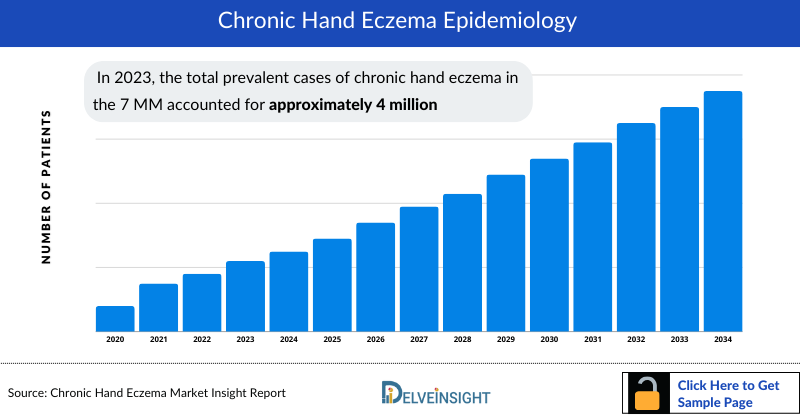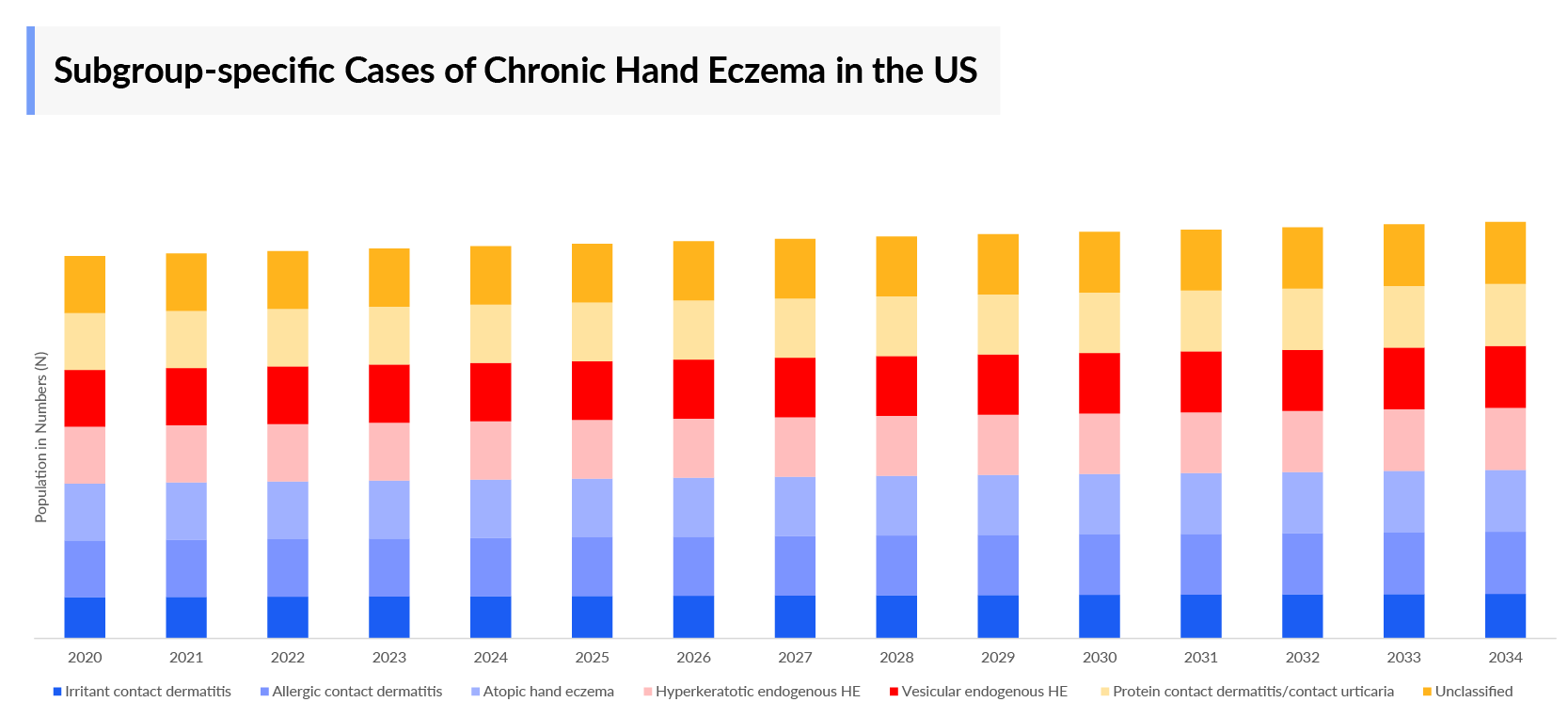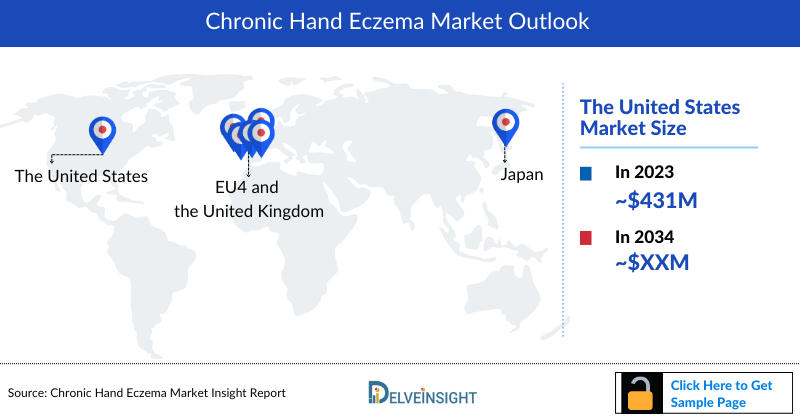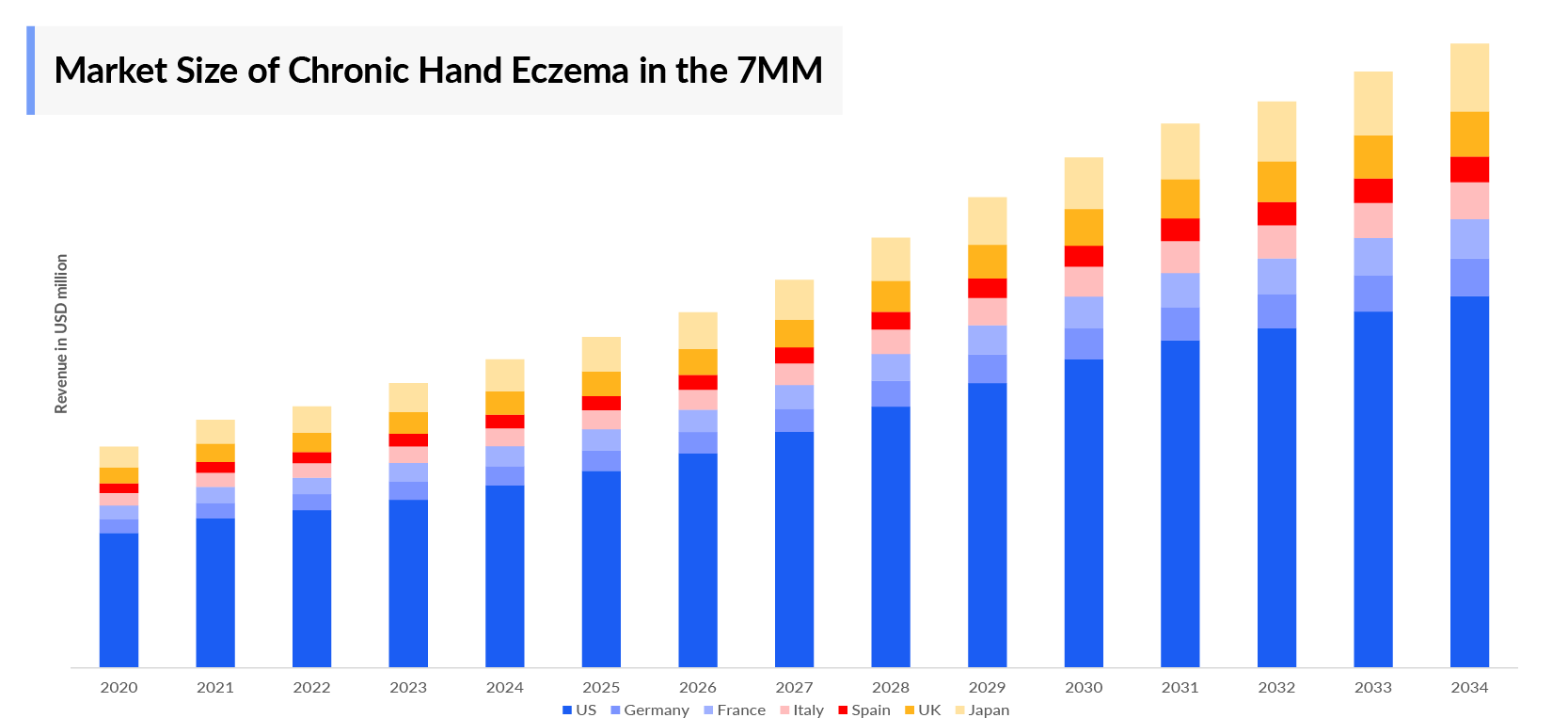Chronic Hand Eczema Market
- The Chronic Hand Eczema market size in the 7MM is anticiapted to grow with a significant CAGR during the study period (2020-2034).
- In 2023, the total Chronic Hand Eczema market size in the US accounted for ~USD 431 million.
- Among EU4 and the UK, Germany accounted for the highest market size, approximately USD 71 million, followed by France and the UK with nearly USD 46 million and USD 45 million respectively in 2023.
- As per DelveInsight’s analysis, in 2023, the total prevalent cases of chronic hand eczema in the 7 MM accounted for approximately 4 million, out of which the US accounted for nearly 2 million cases. These cases are expected to increase during the forecast period owing to the increased exposure to potential triggers for hand eczema, such as frequent handwashing, and the use of harsh chemicals in household cleaners and personal care products.
- Among EU4 and the UK, Germany accounted for the highest prevalent cases of chronic hand eczema i.e. nearly 493 thousand cases followed by France and the UK accounting for approximately 321 thousand and 317 thousand cases respectively.
- Modern lifestyles often involve increased exposure to potential triggers for hand eczema, such as frequent handwashing, the use of harsh chemicals in household cleaners and personal care products, and occupational exposures to irritants or allergens in industries such as healthcare, food service, and manufacturing.
- Additionally, while maintaining proper hand hygiene is crucial for curbing infections, overuse of harsh soaps or sanitizers can compromise the skin barrier, heightening the risk of hand eczema. Public health crises like the COVID-19 pandemic may intensify this concern due to increased emphasis on hygiene practices.
- Chronic hand eczema heterogeneity, or the fact that it can manifest differently from one person to another, adds another layer of complexity. There's a lack of a universally accepted classification system for hand eczema, which can make diagnosis and treatment decisions more difficult.
- Chronic Hand Eczema Treatment typically involves a combination of therapies aimed at alleviating symptoms and improving skin health. This often includes applying topical corticosteroids or calcineurin inhibitors to decrease inflammation and itchiness. Regular use of moisturizers and emollients helps to keep the skin hydrated and maintain its protective barrier.
- Patients are advised to avoid potential triggers by taking protective measures and making lifestyle adjustments. In severe cases, phototherapy or systemic medications may be recommended under the supervision of a dermatologist. Ongoing monitoring and adjustment of treatment by healthcare professionals are essential for achieving the best possible outcomes.
- Living with chronic hand eczema can take a toll on mental health, leading to feelings of frustration, embarrassment, and low self-esteem. There is a need for increased access to psychological support services, including counseling and support groups, to help individuals cope with the emotional impact of their condition.
- Key Chronic Hand Eczema Companies like Regeneron, Sanofi, Stiefel Laboratories, Asana Biosciences, and others are under investigation for potential use in chronic hand eczema anticipated to be launched during the forecast period (2024-2034).
Request for unlocking the Sample Page of the "Chronic Hand Eczema Treatment Market"
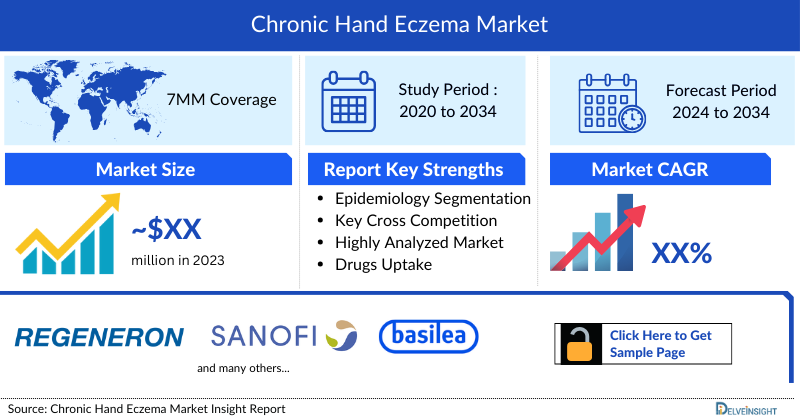 DelveInsight’s “Chronic Hand Eczema Market Insights, Epidemiology, and Market Forecast – 2034” report delivers an in-depth understanding of chronic hand eczema, historical and forecasted epidemiology, as well as the chronic hand eczema therapeutics market trends in the United States, EU4 (Germany, France, Italy, and Spain) and the United Kingdom, and Japan.
DelveInsight’s “Chronic Hand Eczema Market Insights, Epidemiology, and Market Forecast – 2034” report delivers an in-depth understanding of chronic hand eczema, historical and forecasted epidemiology, as well as the chronic hand eczema therapeutics market trends in the United States, EU4 (Germany, France, Italy, and Spain) and the United Kingdom, and Japan.
The Chronic Hand Eczema Treatment Market Report provides current treatment practices, emerging drugs, market share of individual therapies, and current and forecasted 7MM chronic hand eczema market size from 2020 to 2034. The report also covers chronic hand eczema treatment market practices/algorithms and unmet medical needs to curate the best opportunities and assess the market’s potential.
| Study Period | 2020 to 2034 |
| Forecast Period | 2024-2034 |
| Geographies Covered |
|
| Chronic Hand Eczema Market |
|
| Chronic Hand Eczema Market Size | |
| Chronic Hand Eczema Companies | LEO Pharma, Japan Tobacco, Asana Biosciences, and others. |
| Chronic Hand Eczema Epidemiology Segmentation |
|
Chronic Hand Eczema Treatment Market
Chronic hand eczema is a common inflammatory skin condition characterized by dry, red, itchy, and often painful patches on the hands. It can manifest as acute flare-ups followed by periods of remission or persist as a chronic condition. Various factors can contribute to its development, including genetic predisposition, environmental triggers like irritants or allergens, frequent hand washing, and stress. The condition can significantly impact an individual's quality of life, affecting their ability to perform daily tasks and causing discomfort and embarrassment.
Chronic hand eczema diagnosis
Diagnosing chronic hand eczema typically involves a comprehensive evaluation by a dermatologist or healthcare provider. The diagnosis is primarily based on a thorough medical history, physical examination, and sometimes additional tests. During the examination, the healthcare provider will assess the appearance and distribution of skin lesions, inquire about symptoms such as itching or pain, and discuss potential triggers or aggravating factors. They may also inquire about the patient's occupation, hobbies, and personal care habits to identify potential sources of irritation or allergens. In some cases, patch testing may be recommended to determine specific allergens triggering the eczema. Additionally, other skin conditions such as contact dermatitis, psoriasis, or fungal infections may need to be ruled out through clinical examination or laboratory tests. Overall, the diagnostic process aims to accurately identify chronic hand eczema and tailor an appropriate treatment plan to manage the condition effectively.
Chronic Hand Eczema Treatment
Treatment options for chronic hand eczema typically involve a blend of methods aimed at lessening inflammation, easing symptoms, and enhancing the skin's protective barrier. These approaches include various medications such as topical corticosteroids, which are commonly used to diminish inflammation and itchiness by directly applying them to the affected skin. Additionally, topical calcineurin Inhibitors serve as an alternative topical medication class that reduces inflammation, particularly in sensitive areas or when corticosteroids are unsuitable for use.
Regular application of moisturizers and emollients is essential for maintaining skin hydration, alleviating irritation, and fortifying the skin barrier. In certain instances, phototherapy, a form of light therapy, may be recommended to alleviate inflammation and enhance symptoms. Chronic Hand Eczema clinical trials are crucial for evaluating new therapies, improving treatments, and enhancing patient outcomes worldwide.
Chronic Hand Eczema Epidemiology
As the market is derived using a patient-based model, the chronic hand eczema epidemiology chapter in the report provides historical as well as forecasted epidemiology segmented by total prevalent cases of chronic hand eczema, diagnosed cases of chronic hand eczema, gender-specific cases of chronic hand eczema, severity specific cases of chronic hand eczema, age-specific cases of chronic hand eczema, and subgroup-specific cases of chronic hand eczema in the 7MM covering the United States, EU4 countries (Germany, France, Italy, and Spain) and the United Kingdom, and Japan from 2020 to 2034.
- As per DelveInsight’s analysis, in 2023, the total prevalent cases of chronic hand eczema in the 7 MM accounted for approximately 4 million, out of which the US accounted for nearly 2 million cases. These cases are expected to increase during the forecast period owing to the increased exposure to potential triggers for hand eczema, such as frequent handwashing, and the use of harsh chemicals in household cleaners and personal care products.
- Among EU4 and the UK, Germany accounted for the highest prevalent cases of chronic hand eczema i.e. nearly 493 thousand cases followed by France and the UK accounting for approximately 321 thousand and 317 thousand cases respectively.
- There were nearly 1 million diagnosed cases of chronic hand eczema in the US. These cases are expected to increase by 2034 due to environmental factors such as weather conditions, and lifestyle factors such as stress and poor skincare habits.
- Females are affected more than males by chronic hand eczema due to irritants from household and skincare products. In 2023, there were approximately 1 million females and 993 thousand males with chronic hand eczema, in the US.
- In the UK in 2023, there were nearly 52 thousand, 98 thousand, 29 thousand, and 26 thousand cases chronic hand eczema belonging to the age group 20-29 years, 30-49 years, 50-69 years, 70 and above respectively.
- Assessments as per DelveInsight’s analysis show that a maximum number of cases belong to moderate chronic hand eczema. In the UK there were a total of approximately 30 thousand prevalent cases of moderate chronic hand eczema in 2023, followed by nearly 21 thousand and 15 thousand mild and severe cases respectively.
- In 2023, Japan represented almost 15% of all chronic hand eczema cases globally. Among the different subgroups, irritant contact eczema had the highest prevalence at around 27%, whereas fingertip eczema had the lowest, accounting for approximately 4% of the cases. These cases are expected to increase by 2034 driven by the modern lifestyles that lead to high stress levels, poor dietary habits, and sedentary behavior exacerbating inflammatory conditions like eczema in Japan.
Stay ahead with insights on Chronic Hand Eczema prevalence and patient population projections.
Chronic Hand Eczema Recent Developments
- On September 23, 2024, LEO Pharma Inc. made headlines with two major announcements. First, the Food and Drug Administration (FDA) accepted the New Drug Application (NDA) for delgocitinib cream 20 mg/g (2%), a treatment aimed at adults suffering from moderate to severe Chronic Hand Eczema (CHE). This is especially significant for patients who have not responded well to topical corticosteroids or for whom such treatments are unsuitable.
- On September 23, 2024, LEO Pharma A/S also revealed that the European Commission (EC) had granted marketing authorization for Anzupgo® (delgocitinib) cream. This approval opens up a new treatment avenue for adult patients with moderate to severe CHE in Europe, where traditional corticosteroid therapies have fallen short. These dual announcements reflect LEO Pharma's ongoing leadership in medical dermatology and mark a significant milestone in improving care for patients with chronic hand eczema.
Chronic Hand Eczema Drug Chapters
The drug chapter segment of the chronic hand eczema treatment market report encloses a detailed analysis of chronic hand eczema-marketed drugs and late-stage (Phase III and Phase II) Chronic Hand Eczema pipeline drugs. It also helps understand chronic hand eczema clinical trials details, expressive pharmacological action, agreements and collaborations, approval and patent details, advantages and disadvantages of each included drug, and the latest news and press releases. The Chronic Hand Eczema drugs market is witnessing growth due to rising cases, improved treatments, and increasing healthcare awareness globally.
Chronic Hand Eczema Marketed Drugs
- TOCTINO (alitretinoin): Basilea Pharmaceutica/ Stiefel Laboratories
TOCTINO (alitretinoin) is an endogenous metabolite of vitamin A. Alitretinoin belongs to the chemical class of retinoids among which isotretinoin (13-cis-retinoic acid) derivative. Retinoids are typically used to treat skin disorders. It is indicated for use in adults who have severe chronic hand eczema that is unresponsive to treatment with potent topical corticosteroids. Patients in whom eczema has predominantly hyperkeratotic features are more likely to respond to treatment than those in whom eczema predominantly presents as pompholyx. Alitretinoin is an investigational product in the US and an approved product in multiple European countries, Canada, and Israel for the treatment of severe chronic hand eczema, refractory to treatment with a potent topical corticosteroid. It has not been approved for use in the US as well as in Japan.
Stay ahead with key updates on Chronic Hand Eczema treatments. Access the 2025 pipeline report for exclusive insights!
Chronic Hand Eczema Emerging Drugs
- Delgocitinib: LEO Pharma/Japan Tobacco
Delgocitinib (LP0133) is a topical ATP-competitive Janus kinase (pan-JAK) inhibitor for the treatment of inflammatory skin diseases and is intended to offer an improved safety profile compared to topical steroids. Delgocitinib blocks various cytokine signaling pathways and widely suppresses the activation of immune and inflammatory cells, such as T cells, B cells, mast cells, and monocytes which release inflammatory cytokines, such as IL-4, IL-16, and IFN-γ. It improves autoimmune and allergic diseases by inhibiting the action of JAKs, which play key roles in immune activation signaling in cells, by suppressing the over-activation of immune responses. It also promotes keratinocyte production of filaggrin in the skin barrier. Currently, the company is at the filling stage of drug development.
- ARQ-252: Arcutis Biotherapeutics
ARQ-252 is a topical janus kinase 1 (JAK1) inhibitor that has promise as a novel treatment for inflammatory dermatologic diseases, including chronic hand eczema and vitiligo. Many inflammatory cytokines and other signaling molecules rely on the JAK pathway, specifically JAK1, which plays a central role in immune system function. Inhibition of JAK1 has been shown to treat a range of inflammatory diseases, including rheumatoid arthritis, psoriasis, Crohn’s disease, and atopic dermatitis. ARQ-252 is differentiated from other topical JAK inhibitors by its high potency and unique selectivity against JAK1 compared to JAK2. ARQ-252’s selectivity for JAK1 may confer important safety advantages compared to other topical JAK inhibitors.
Currently, the drug candidate is being investigated in a preclinical stage for treating chronic hand eczema and vitiligo.
- ASN002: Asana BioSciences
ASN002 (Gusacitinib) is a potent dual inhibitor of JAK and SYK kinases, which are involved in both cytokine production and signaling. ASN002 inhibits JAK-mediated cytokine signaling and JAK-SYK mediated T- and B-cell proliferation and function. Gusacitinib was granted FDA Fast-Track Designation for moderate-to-severe chronic hand eczema. The drug candidate has completed Phase II clinical evaluation in moderate-to-severe chronic hand eczema patients.
Note: Further emerging therapies and their detailed assessment will be provided in the final report.
Chronic Hand Eczema Drugs Market Insights
Various drug classes are commonly utilized in treating chronic hand eczema. Topical corticosteroids serve as the primary treatment due to their anti-inflammatory properties, effectively alleviating itching, redness, and swelling associated with eczema flare-ups. However, their prolonged usage can result in skin thinning and other adverse effects, necessitating short-term prescriptions or combination therapies. Another class, topical calcineurin inhibitors like tacrolimus and pimecrolimus, suppress the skin's immune response, proving beneficial for sensitive areas like the face and hands. Emollients and moisturizers play a vital role in managing chronic hand eczema by repairing the skin barrier, reducing water loss, and soothing dry, irritated skin. Often, they are combined with other treatments to uphold skin hydration and deter flare-ups. Additionally, topical immunomodulators such as crisaborole modulate the skin's immune response, diminishing inflammation and eczema symptoms. They are typically employed when corticosteroids or calcineurin inhibitors prove ineffective or intolerable.
Chronic Hand Eczema Market Outlook
The current treatment options for chronic hand eczema primarily include topical therapies such as corticosteroids, calcineurin inhibitors, and emollients/moisturizers. These treatments focus on alleviating symptoms, reducing inflammation, and restoring the skin barrier. In severe cases, systemic therapies like oral medications or biologics may be considered. The treatment market for chronic hand eczema is dynamic and driven by various factors, including advancements in medical understanding, emerging therapies, evolving patient preferences, increasing awareness about eczema management among healthcare professionals and patients, and environmental and lifestyle factors.
A few key Chronic Hand Eczema Companies such as Asana Biosciences, LEO Pharma, Japan Tobacco, Regeneron, Sanofi, and others are expected to change the market dynamic during the forecast period (2024-2034).
- According to DelveInsight, the overall dynamics of the chronic hand eczema market are anticipated to change during the forecast period (2024-2034) owing to advancements in medical research and technology, improved diagnostic tools, and emerging of novel therapies.
- In 2023, the total Chronic Hand Eczema market size in the US accounted for nearly USD 431 million.
- Among EU4 and the UK, Germany accounted for the highest market size, approximately USD 71 million, followed by France and the UK with nearly USD 46 million and USD 45 million respectively in 2023.
- With the launch of potential emerging therapies, there is an expected change in the chronic hand eczema market dynamics.
- The chronic hand eczema market size in Japan accounted for nearly USD 93 million of the total market share in 2023.
Chronic Hand Eczema Uptake
This section focuses on the uptake rate of potential Chronic Hand Eczema drugs expected to be launched in the market during 2020–2034. For example, Asana BioScience’s ASN002 (Gusacitinib), a dual inhibitor of JAK and SYK kinases involved in both cytokine production and signaling has demonstrated rapid and significant improvement in the treatment of patients with moderate-to-severe chronic hand eczema compared to placebo, with a tolerable safety profile.
Chronic Hand Eczema Pipeline Development Activities
The Chronic Hand Eczema therapeutic market report provides insights into different Chronic Hand Eczema clinical trials within Phase III, Phase II, and Phase I. It also analyzes key Chronic Hand Eczema Companies involved in developing targeted therapeutics.
Pipeline development activities
The Chronic Hand Eczema therapeutics market report covers information on collaborations, acquisitions and mergers, licensing, and patent details for emerging therapies for chronic hand eczema.
KOL Views
To keep up with current market trends, we take KOLs and SMEs’ opinions working in the domain through primary research to fill the data gaps and validate our secondary research. Industry Experts contacted for insights on chronic hand eczema evolving treatment landscape, patient reliance on conventional therapies, patient therapy switching acceptability, and drug uptake, along with challenges related to accessibility, including Medical/scientific writers, Medical Professionals, Professors, Directors, and Others.
DelveInsight’s analysts connected with 50+ KOLs to gather insights; however, interviews were conducted with 15+ KOLs in the 7MM. Centers like the Mount Sinai College of Medicine, University Hospital Dusseldorf Dermatology, and Osaka University, were contacted. Their opinion helps understand and validate current and emerging therapy treatment patterns or chronic hand eczema market trends. This will support the clients in potential upcoming novel treatments by identifying the overall scenario of the market and the unmet needs.
| Region | KOL Views |
| Germany | Incidence & prevalence of hand eczema or chronic hand eczema are lacking, however, there have been estimates that reveal that Hand Eczema occurs in one in ten adults. I have 1 patient who comes in with this condition, and seeing as my area is densely populated, the condition is very rare with ~5-7% cases of CHE.” |
| The US | One-year, self-reported prevalence of adult hand eczema is around 10%, where chronic hand eczema cases are almost 6% of hand eczema cases” |
| Japan | The long-term treatment options for chronic hand eczema refractory to topical corticosteroids are currently limited. In search of a safer therapy, oral alitretinoin was developed for chronic hand eczema, but its economic burden limits its broader use. Therefore, the socioeconomic burden on patients cannot be ignored and needs to be considered, especially because the disease can be chronic. To meet this need, Acitretin, a synthetic retinoid, is an alternative treatment for hand eczema is used that is more cost-effective than alitretinoin. It resulted in a satisfactory outcome at an acceptable cost for our patients. |
Physician’s View
According to physicians, a primary challenge in the treatment of chronic hand eczema is the management of symptoms in a way that balances efficacy with safety and tolerability. This delicate balance is particularly challenging due to the chronic nature of the condition, variability in patient response to treatment, and the need for long-term management strategies. Moreover, physicians often encounter difficulties in finding the most suitable treatment approach for individual patients, as responses to therapies can vary widely. While some patients may respond well to topical corticosteroids or calcineurin inhibitors, others may experience limited efficacy or adverse effects from these medications. This variability underscores the importance of personalized treatment plans tailored to each patient's specific needs and preferences.
Qualitative Analysis
We perform Qualitative and Chronic Hand Eczema Drugs Market Intelligence analysis using various approaches, such as SWOT analysis and Attribute Analysis. In the SWOT analysis, strengths, weaknesses, opportunities, and threats in terms of disease diagnosis, patient awareness, patient burden, competitive landscape, cost-effectiveness, and geographical accessibility of therapies are provided. These pointers are based on the Analyst’s discretion and assessment of the patient burden, cost analysis, and existing and evolving treatment landscape.
Attribute analysis analyzes multiple emerging therapies based on relevant attributes such as safety, efficacy, frequency of administration, route of administration, and order of entry. Scoring is given based on these parameters to analyze the effectiveness of therapy. In efficacy, the trial’s primary and secondary outcome measures are evaluated; for instance, in chronic hand eczema trials, one of the most important primary outcome measures is complete eschar removal.
Further, the therapies’ safety is evaluated wherein the acceptability, tolerability, and adverse events are majorly observed, and it sets a clear understanding of the side effects posed by the drug in the trials. In addition, the scoring is also based on the route of administration, order of entry and designation, probability of success, and the addressable patient pool for each therapy. According to these parameters, the final weightage score and the ranking of the emerging therapies are decided.
Chronic Hand Eczema Therapeutics Market Access and Reimbursement
The high cost of therapies for the treatment is a major factor restraining the growth of the drug market. Because of the high cost, the economic burden is increasing, leading the patient to escape from proper treatment. The reimbursement challenges related to medical care and treatment for individuals with chronic hand eczema can be significant as they often require specialized medical attention, covering the costs of diagnosis, treatment, and ongoing care. Health insurance plans may not fully cover limited coverage of some medical treatments, and therapies specific to chronic hand eczema. This can result in high out-of-pocket expenses for families seeking the best care for their loved ones. Moreover, it requires specialized care from healthcare providers with expertise. Finding and accessing such specialists may be challenging, and the associated costs may not always be fully reimbursed by insurance.
Further details will be provided in the report...
Chronic Hand Eczema Therapeutics Market Report Scope
- The Chronic Hand Eczema treatment market report covers a segment of key events, an executive summary, descriptive overview, explaining its causes, signs and symptoms, pathogenesis, and currently available therapies.
- Comprehensive insight has been provided into the epidemiology segments and forecasts, the future growth potential of diagnosis rate, disease progression, and treatment guidelines.
- Additionally, an all-inclusive account of the current and emerging therapies, along with the elaborative profiles of late-stage and prominent therapies, will impact the current treatment landscape.
- A detailed review of the chronic hand eczema treatment market, historical and forecasted Chronic Hand Eczema market size, market share by therapies, detailed assumptions, and rationale behind our approach is included in the report, covering the 7MM drug outreach.
- The Chronic Hand Eczema therapeutics market report provides an edge while developing business strategies, by understanding trends, through SWOT analysis and expert insights/KOL views, patient journey, and treatment preferences that help shape and drive the 7MM chronic hand eczema drugs market.
Chronic Hand Eczema Therapeutics Market Report Insights
- Patient-based Chronic Hand Eczema Market Forecasting
- Chronic Hand Eczema Therapeutic Approaches
- Chronic Hand Eczema Pipeline Analysis
- Chronic Hand Eczema Market Size and Trends
- Chronic Hand Eczema Drugs Market
- Existing and Future Chronic Hand Eczema Drugs Market Opportunity
Chronic Hand Eczema Therapeutics Market Report Key Strengths
- 11 years Chronic Hand Eczema Market Forecast
- The 7MM Coverage
- Chronic Hand Eczema Epidemiology Segmentation
- Key Cross Competition
- Attribute analysis
- Chronic Hand Eczema Drugs Uptake and Key Market Forecast Assumptions
Chronic Hand Eczema Drugs Market Report Assessment
- Current Chronic Hand Eczema Treatment Market Practices
- Chronic Hand Eczema Unmet Needs
- Chronic Hand Eczema Pipeline Product Profiles
- Chronic Hand Eczema Drugs Market Attractiveness
- Qualitative Analysis (SWOT and Attribute Analysis)
- Chronic Hand Eczema Market Drivers
- Chronic Hand Eczema Market Barriers
Key Questions Answered In The Chronic Hand Eczema Market Report:
Chronic Hand Eczema Therapeutics Market Insights
- What was the chronic hand eczema drugs market share (%) distribution in 2020 and what it would look like in 2034?
- What was the total Chronic Hand Eczema market size by therapies, and Chronic Hand Eczema market share (%) distribution in 2020, and what would it look like by 2034? What are the contributing factors for this growth?
- How will ARQ-252, and Delgocitinib affect the treatment paradigm of chronic hand eczema?
- How will TOCTINO (alitretinoin) compete with upcoming products?
- Which drug is going to be the largest contributor by 2034?
- What are the pricing variations among different geographies for approved and marketed therapies?
- How would future opportunities affect the market dynamics and subsequent analysis of the associated trends?
Chronic Hand Eczema Epidemiology Insights
- What are the disease risks, burdens, and Chronic Hand Eczema unmet needs? What will be the growth opportunities across the 7MM concerning the Chronic Hand Eczema patient population?
- What is the historical and forecasted chronic hand eczema patient pool in the United States, EU4 (Germany, France, Italy, and Spain) the United Kingdom, and Japan?
- Out of the above-mentioned countries, which country would have the highest prevalent chronic hand eczema population during the forecast period (2023–2034)?
- What factors are factors contributing to the growth of chronic hand eczema cases?
Current Chronic Hand Eczema Treatment Market Scenario, Marketed Drugs, and Emerging Therapies
- What are the current options for the treatment of chronic hand eczema? What are the current guidelines for treating chronic hand eczema in the US and Europe?
- How many companies are developing therapies for the treatment of chronic hand eczema?
- How many emerging therapies are in the mid-stage and late stage of development for treating chronic hand eczema?
- What are the recent novel therapies, targets, mechanisms of action, and technologies developed to overcome the limitations of existing therapies?
- What is the cost burden of current treatment on the patient?
- Patient acceptability in terms of preferred treatment options as per real-world scenarios?
- What are the country-specific accessibility issues of approved therapies?
- What is the 7MM historical and forecasted market of chronic hand eczema?
Reasons to Buy Chronic Hand Eczema Market Forecast Report:
- The Chronic Hand Eczema treatment market report will help develop business strategies by understanding the latest trends and changing treatment dynamics driving the chronic hand eczema dugs market.
- Insights on patient burden/disease Chronic Hand Eczema prevalence, evolution in diagnosis, and factors contributing to the change in the epidemiology of the disease during the forecast years.
- Understand the existing market opportunities in varying geographies and the growth potential over the coming years.
- Distribution of historical and current patient share based on real-world prescription data in the US, EU4 (Germany, France, Italy, and Spain) the United Kingdom, and Japan.
- Identifying strong upcoming players in the Chronic Hand Eczema drugs market will help devise strategies to help get ahead of competitors.
- Detailed analysis and ranking of class-wise potential current and emerging therapies under the conjoint analysis section to provide visibility around leading classes.
- Highlights of access and reimbursement policies for chronic hand eczema, barriers to accessibility of approved therapy, and patient assistance programs.
- To understand Key Opinion Leaders’ perspectives around the accessibility, acceptability, and compliance-related challenges of existing treatment to overcome barriers in the future.
- Detailed insights on the unmet needs of the existing market so that the upcoming players can strengthen their development and launch strategy.
Stay Updated with us for Recent Articles

